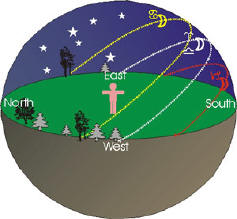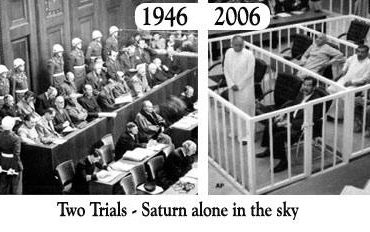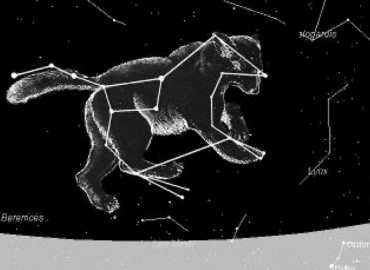Bernadette Brady
March 2007
Cast yourself back four thousand years or so into Mesopotamia and place yourself outside looking out over the clear night sky watching a glorious full moon. This full moon is special because it is occurring not only with the planet Saturn (symbolic of the king) but that Saturn has moved near the king’s star – Regulus. Here is the moon god Sin, clearly bestowing power and blessings on the king and his realm.
But as you watch this full moon, the predictions and warnings of the priest comes to pass, for the moon god Sin turns to blood in front of your eyes. Your only thought is to hope that the king has performed the rituals prescribed by the priest in order to avoid the disaster indicated by such a powerful omen. Surely, you ponder, the substitute king will die in the face of such a strong visual omen.

There has been much astrological “water under the bridge” since those early stirrings of astrology but the sky does not change, only our attitude to it.
Is this omen, given to us on the evening 3 March, 2007, still important? Can we turn our modern eyes away from such a powerful visual experience of a blood moon with Regulus and Saturn all standing together in a straight line in the evening sky over Europe?
The questions that flood our modern astrological minds are no longer about rituals and substitute kings but rather we ask ourselves how often does this happen and what has it heralded, if anything in the past?
I used Jigsaw to scan through the last 1,000 years of ephemeris and found that this visual phenomenon occurs every second century. In one century there will be a total, or nearly total lunar eclipse in the constellation Leo when Saturn is also present. This phenomenon will occur in the early months of the year for possibly a few consecutive years. After this it may be seen once again when Saturn is amongst the stars of Leo (29 or roughly 58 years later), however this will be later in the century. After that the phenomenon disappears for a century, to return again in the following century.
Thus in the last 1,000 years we have had this event in the 11th century, 13th century, 15th century, 17th century, 19th century and now we are beginning the “cycle” again in the 21st century.
The Pattern – A lunar eclipse near Regulus while Saturn is around the stars of Leo and the eclipse visible over Europe.
The 11th Century
Eclipse on 3 March1067– The death of the Byzantine Emperor – Constantine X on 22 May.
The 13th Century
Eclipse on 23 January 1274 – King Edward I of England finally returns from the Ninth Crusade to England to be crowned king, two years after his father King Henry III’s death.

The 15th Century – Regicide
On the night of the 18 January 1478 in Europe the full moon rose with “unwashed feet” followed by Saturn and then Regulus. By April of that year a reigning monarch had been assassinated while at Mass in a cathedral. This was a double outrage, firstly the killing of a king and secondly the violation of the sacred space of a cathedral. The king was Giuliano de Medici, monarch of Florence and there were large repercussion in Florence over this murder with the perpetrators being savagely punished.
(Right Giuliano de Medici painted from his death mask)
The 17th Century – An ill-fated King takes the English throne and European revolts
22 March 1625– The next occurrence of this visual phenomenon over Europe heralded the death of James I of England (died 27 March) and the ill-fated Charles I (later executed) takes the throne.
14 March of 1653 and 3 March of 1654 – Post-English civil war period. Charles I who took the throne in March 1625, had been executed in 1549. Oliver Cromwell was made Lord Protector on 16 December, 1653.
21 February 1682– The Czar of Russia (Fyodor III) died in April/ May without issue which lead to a bloody revolt, “the Moscow Uprising”, which eventually placed Sophia on the Russian throne ruling on behalf of her sons, Ivan and Peter (later known as Peter the Great).
19th Century – another French Revolution but a new Kingdom is formed
9 March, 1830 – The moon rose with “unwashed feet” over Europe with Saturn and Regulus. – This year saw the French Revolution of 1830, also known as the “July Revolution”, where Charles X of France was removed from the throne.

26 February 1831 – Once again the moon rose with “unwashed feet” over Europe with Saturn and Regulus. In this year there was the creation of a new kingdom. The first “King of the Belgians” Leopold I, took the Belgium throne on the 26 June 1831. This confirmed the nobility of the Saxe-Coburg line and it was Leopold I who arranged for his niece (later known as Queen Victoria) to marry his nephew Prince Albert of Saxe-Coburg and Gotha.
(Right: Queen Victoria and Albert, painted by Landseer at Bal Costumé of 12 May 1842)
29 January 1888 – Two Emperors of Germany die in the one year – William I died on March 9 and his son (Frederick III) ruled for only 99 days, succeeded by William II, who was the last Emperor of Germany and Prussia and who took Germany into WWI.
21st Century
3 March, 2007 – There are eleven crowns in Europe; Britain, Denmark, Sweden, Spain, Netherlands, Liechtenstein, Norway, Belgium, Luxembourg, Morocco and let us not forget the Pope in Rome – who also holds a crown. Will there be another episode in the Saxe-Coburg line, the British royal family, or will another crown of Europe change hands?





